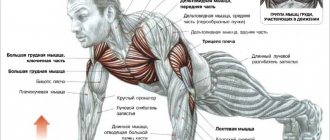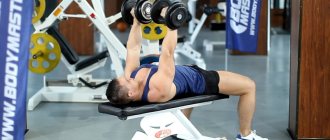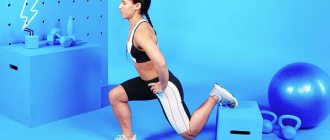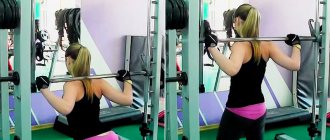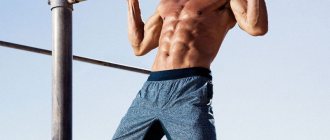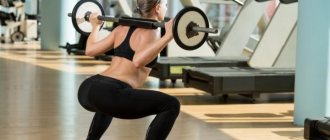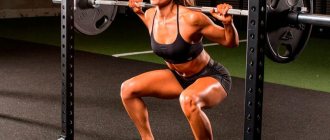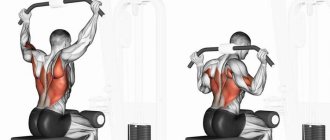In this article, you will learn how to do the back squat with perfect form, as well as how to improve your performance in this exercise.
Key points:
- Barbell squats are one of the best exercises for developing such important muscles and muscle groups in your body as the quadriceps, hamstrings, back muscles, buttocks, and calves.
- Learning the correct technique consists of learning some techniques that form the habit of performing this exercise correctly. I will tell you about them below.
- The classic back squat is a widely recognized effective type of squat, but I suggest looking at the front squat, the Bulgarian squat, and the goblet squat. These exercises are also very effective.
Squats
Squats are one of the most important basic exercises in bodybuilding, fitness and powerlifting. Of course, you can find other exercises to develop your back and leg muscles, but the main benefit lies in developing your overall physical strength. But at the same time, this exercise is very difficult to master.
Squats engage every major muscle group in your body, forcing them to work in harmony and synchronization to generate incredible strength. You need to remember that if you want to squat with serious weights and also avoid injury, you must follow the correct technique. You can use cheating on the bench press or even the deadlift, but cheating won't help with the squat. If you don't have the strength and proper technique, you won't move the weight. After reading this article, you will learn how to master the squat with perfect form, different variations, and 12 ways to improve your performance. I will also present a simple and effective training program.
Let's get started!
What muscles are involved during squats?
The squat is a unique exercise that works every major muscle group in your body except the arms, chest, and shoulders. In particular, squats will help you develop muscles such as:
- Quadriceps
- Biceps hamstrings
- Gluteal muscles
- Hip flexors
- Spinal stabilizer muscles
- Latissimus dorsi muscles
- Trapeze
- Calf muscles
As you know, many muscles in the body are antagonists to each other. For example, biceps-triceps, when you perform some kind of biceps exercise (barbell lifting or some other), your triceps practically do not work. Obviously, engaging the triceps in this case will not help you with the biceps exercise. The leg muscles - quadriceps and hamstrings - are also antagonists. But due to an amazing feature of human anatomy called Lombard's paradox, squats involve both muscles at the same time. It is for this reason that they are so effective and yet so complex.
How to squat with a barbell correctly - sequence
Sit back and spread your knees apart
A very important nuance - you need to squat not just down, but as if a little back on a stump that is behind you, and not under you. A correct squat is performed by moving the gluteal muscles back and spreading the knees to the sides. This will properly load your buttocks and hamstrings. And keep your lumbar region healthy.
Don't make the biggest mistake of all beginners - squatting down instead of squatting back.
This technique limits the depth of the squat, greatly reduces the risk of injury due to the increased load on the knee joints, and also transfers most of the load to the quadriceps. This is not a simple technique, but it is correct and safe. To understand it better, you can first start squatting on the bench. Later I will explain how to do this.
Keep your chest up
When performing squats or deadlifts, your chest should always face forward during any phase of the exercise. Remember this. When moving down with a barbell during a squat, you should always keep your chest up. This makes it easier to keep your back straight to perform the movement safely. During squats, you should not round your back, so as not to lose strength and energy, and most importantly, to protect the spine from injury.
How deep should and can you squat?
The age-old question: how deep should you squat? How deep you squat is influenced by many facts that determine depth:
- Ankle mobility
- Pelvic mobility
- Lumbar stability
- Shoulder bar position (high vs. low)
- According to the rules of which powerlifting federation do you squat (if this is the case for you)
- What kind of powerlifting equipment do you use?
- Other
The main thing is to adhere to the rule: the depth of the squats should be such that you can achieve the goals you set for the squats without putting yourself at risk of injury. When doing squats, it is important to monitor the position of your back; it should always be straight and not rounded. Therefore, if with a straight back you can only squat slightly above the thigh parallel to the floor, then this means that this is your squat depth at this stage.
Press your back out from the bottom point
When lifting a barbell up from the bottom point, you should try not just to stand up, but to push the bar with your back up. The bar should not move along an arc path, but rather vertically, that is, down and up in a straight line. And by trying to push your back against the barbell, you will be able to achieve a straight linear movement of the barbell and keep your chest lifted. If you just try to stand up, the barbell will definitely move a little forward, so you will lose the correct center of gravity and, as a result, lose control over the barbell.
Keep your knees turned out
Spread your knees out to the side as you move up with the barbell. You should not allow your knees to close during the lift so that the weight of the barbell is not transferred to the quadriceps and adductor muscles.
What muscles work when squatting?
In squats, the main working muscle groups are:
- Leg muscles
- Backs
- Abdominals
Squats are a multi-joint compound exercise that engages large and small muscle groups. The squat involves almost every muscle in the lower body. Depending on the chosen squat option, the emphasis of the load will shift to one group or another. During a classic squat with a barbell on the shoulders, the quadriceps are involved in the work; the synergists (muscles that help in movement) are the gluteus maximus, the adductor muscles of the thigh, and the soleus muscles. The hamstrings act as stabilizers along with the calf muscles. A significant part of the load falls on the abdominal muscles, as well as on the back extensors. This exercise also involves the smaller muscles of the torso and legs.
And take note: if you start to lean forward too much when doing barbell squats, it means your legs are weak, not your back.
Remember this moment, you will return to it more than once in your training. When you bring your knees together during barbell squats, you place high stress on the transverse knee joint, which will inevitably lead to injury to this joint. And if you go to squat for a long time and effectively, then you need to do everything to keep your knee joints healthy. You should strive to maintain the foot-knee-hip system; they should always be in the same position, that is, directed to the same point. If you look at a proper 45° squat, you will notice that the feet, knees and hips are pointing in the same direction and in the same line.
Finishing the repetition
When moving up with a barbell on your shoulders, you need to exhale forcefully, you can scream if you like, help yourself in any convenient way to stand up with the barbell.
That's all, you know how to squat with a barbell correctly to get the desired effect in the form of strength and mass. And you also know how to protect yourself from injuries when doing squats. When working with heavy weights on a barbell, it is possible to take short rests at the top point. Then take a deep breath again, tighten your chest and extend your elbows if necessary. Always ensure proper squat technique and breathe, breathe deeply.
In conclusion, watch the video in Russian on the barbell squat technique:
How to squat with perfect form?
Complex multi-joint (basic) exercises require strict adherence to the correct technique. Otherwise, such exercises may injure you. Let's look step by step at how to learn how to squat correctly and look at all the nuances in detail, including each element of the movement, shoes, additional equipment and even nutrition. First, watch the first few seconds of the following video to get an idea of what we're talking about.
Next, let's look at three steps to mastering proper technique, starting from the starting position.
How to progress
There are so many methods to “boost” your barbell squat performance. But the whole point rests only on 2 basic principles:
- Thoughtful periodization of loads, when you train taking into account percentages of the maximum possible weight for you or alternate heavy workouts with light ones. Lifters who compete typically train their legs twice a week. In one workout, they use 50-60% of their maximum in 3 sets of 5-6 repetitions. On the second one, work 75-85% of the maximum in 5 sets of 5 repetitions. On the eve of the competition, repetitions are reduced and the weight of the apparatus is increased.
- Performing assistance exercises such as front squats (front squats), overhead squats. They also use forward bends with a barbell on their shoulders, as they help hone the ability to hold the body with a large weight of the barbell during classic squats.
Alternative types of squats
The back squat is just one type of squat, there are others:
- Front Squats
- Bulgarian squats
- Goblet Squats
You can use each of these variations instead of or in addition to classic squats to add variety to your program. Let's take a closer look at each of these options.
Front Squats
Front squats are my favorite leg exercise. In general, the movement itself below the belt remains almost the same as with classic squats. The key difference is that the barbell does not lie on your back, but is held on your shoulders in front.
It looks like this:
The advantage of the front squat is that it places more emphasis on the quadriceps and upper back, and that it allows for a much deeper range of motion. The disadvantage of front squats is that you can use significantly less weight than with the classic version, and front squats may also seem less comfortable to some.
Front squats also require some mobility in your wrists, which is why some people hold their hands like this:
This grip is more comfortable, but it is less stable and does not allow you to work with heavy weights. I would recommend not crossing your arms, even if you can only grip the bar with one or two fingers.
Also, when performing front squats, it is possible to place your legs much closer to each other - at shoulder width or even narrower. This allows you to shift the load to the outer part of the quadriceps while maintaining deep amplitude.
Bulgarian squats
It is not without reason that Bulgarian squats have become increasingly popular lately. They look like this:
Research shows that this exercise can actively affect your strength in the classic squat, and specifically your one-time maximum. Bulgarian squats significantly reduce the load on the lower back, and also involve more of the hamstrings, which are less actively involved in the frontal version. This exercise also allows you to concentrate on working each leg separately, focusing your attention on the work of target muscle groups.
The disadvantage of Bulgarian squats is that the working weight, of course, will be significantly less than in other types of squats. This exercise falls more into the auxiliary category.
Goblet Squats
Goblet squats are technically very similar to front squats, the difference being that you use dumbbells instead of a barbell. They look like this:
Hold the dumbbell in front of you and do not let it move away from your chest. The main advantage of this type of squat is that you don't need a barbell to perform it. If you are traveling or practicing at home, this exercise can be a good alternative. This exercise will also be useful if for some reason you experience pain in the shoulder girdle or back when doing squats with a barbell.
How to squat with a barbell: preparation
Visualization
To learn how to do squats with a barbell correctly, before visiting the gym, you need to clearly imagine the exercise, all its nuances, and most importantly, imagine the work of each muscle involved in the exercise. This applies not only to squats, but to any other thing. You also need to learn to feel the muscles that you are going to train, in our case with the help of squats. This way you will be psychologically prepared to perform the exercise efficiently, and then you can start doing squats.
Tight T-shirt
A fitted T-shirt isn't just good for showing off your athletic body and biceps. In a slightly smaller T-shirt, it is better to feel the barbell on your shoulders, especially when the barbell is positioned low on your shoulders.
Hands on the bar, narrow grip
Now let's talk about gripping the barbell in squats. You need to grab the barbell with an overhand closed grip. If you're a big guy or don't have much mobility in your shoulders, you'll have to use a wide grip. But lightweights and athletes with a mobile shoulder joint need to grip the barbell with a grip slightly wider than shoulder-width. With this position of your arms, your shoulder blades will be compressed, your upper body will be secured, and your chest will be pushed forward. And the bar itself will be securely fastened to the back for safe squats.
Dive under the barbell, move your shoulders back
You have taken the barbell correctly, now you need to crawl under it. Approach the bar and take a step under it, then squeeze your shoulder blades together, moving your shoulders back. With this movement, you create a “cushion” of muscles in the back of your upper back on which you place the barbell. The bar should rest on the trapezius muscle in line with the rear delts. If the barbell crashes into your back, it means you haven't pulled your shoulders back well. And no need to wrap a towel around the barbell, just watch your shoulders. Once you are under the barbell and have squeezed your shoulder blades together, place your feet hip-width apart, feet parallel to each other.
At this stage, it is not yet time to point your feet out to the sides!
Chest up, elbows down
Now you are already under the barbell, your shoulder blades are brought together. Now you need to forcefully lift your chest up (move your chest up and forward). When preparing to remove the barbell, do not lean forward - this is a serious mistake. With this performance, lifting the barbell from the racks will be torture for you. Therefore, to remove the barbell relatively easily, lift your chest up. To check whether your chest is in the correct position or not, lower your elbows down, as if bringing them forward under the barbell. This technique will help stabilize your body/upper torso and get you into the correct squatting position.
Press hard into the barbell
When you have taken the correct position and are ready to remove the bar from the racks, you need to imagine how you sharply push the bar of the bar with your back. This is necessary so that before removing the barbell you can better feel and then control the weight of the barbell in the squat. Don't make the mistake of treating different barbell weights the same way. A weight of 60 kg and a barbell of 150 kg feel differently and respond differently. When squatting with heavy weights, you need to be mentally prepared for the exercise, you need to be determined and not let the bar crush you. Otherwise, if you lose control of the barbell for a second, everything could end sadly. If you have a bad squat mindset, the weight of the barbell will seem greater than it actually is. You must be prepared psychologically, you need to turn on aggression and apply force to the bar, removing a lot of weight from the racks.
Deep breath, stand, let the weight settle
Now it's time to remove the bar from the racks, you are set, you are comfortable under the bar, you are pushing your back hard into it. You need to take a deep breath with your stomach, not your chest, and tense your body muscles. Push the barbell and stand up straight, but don't take a step back yet! First you need to level out and feel the weight on yourself, it should “settle down,” as it were. The barbell will swing and the more weight, the more it will swing. This point needs to be read, because by starting to take steps back with a heavy swinging barbell, you will only increase the amplitude of movement of the swinging bar.
1-2-3, put your feet up
When the weight is already on your shoulders and the bar is not swinging, it’s time to move away from the racks. There is no need to step back into the middle of the hall; it is enough to take one step with each foot and place them in the correct position. I will tell you my method, but you can find your own solution on how to position your legs correctly for squats.
First, I take a step back with my right foot and immediately place it approximately where it will be during the squat. Then I take a step back with my second leg and also immediately place it approximately in the place where it will be during the squat. This way I manage to avoid unnecessary marking time, which takes energy and time. Position but approximately shoulder width apart. If you're a tall guy, you'll need to use your stance a little wider. The toes are turned to the sides, so that during the squat at the lowest point of the amplitude, they point in the same direction as the knees and hips.
Personally, it took me some time to work with a weightlifting coach to find the right foot placement for me. This is almost jewelry work, because there you need to change the position up to a change in position of several millimeters. Try to immediately take two steps to get into the position you need with your legs for squats. With a light weight, you won't understand what the advantage is. But when the working weight on the bar exceeds 100 kg, you are unlikely to want to take extra steps with the barbell on your shoulders in order to prepare for the squat. This will take up a lot of extra energy, which you will need for squats. With each new day of squat training, try to always immediately get into the correct position for squats. Ed Cohen (famous powerlifter, author of 20 records in 4 weight categories) once said that light weight should be treated like heavy weight and then it will also be easier.
Shift your weight back
When you stand with a barbell on your shoulders, its weight should be located at the level of the middle of the foot, or better yet, at the level of the heels. Don't carry the weight of the bar over the middle of your feet towards your toes or even beyond your toes - don't make such gross mistakes in squatting. Before you start squats, you need to make sure that the weight of the barbell is located in the middle of your feet, and preferably at the level of your heels.
Watch the video about squats, it’s in English, but everything is intuitive. The basic idea is that the foot has three main support points, which support the body weight along with the barbell. To get a better feel for how to stand correctly, you can squat barefoot for a while. In my gym, I saw powerlifting guys who trained in Czech shoes to better hold their legs. It's almost like being barefoot, you can try it.
Let's get ready, put our neck in a neutral position, and tense up!
Now you already know what the correct position of the legs should be to perform squats. Before performing a squat, be sure to tense up strongly, this will indicate that you are ready to squat. Inhale deeply (from your stomach, not your chest), lift your chest up, and lower your elbows down under the level of the barbell. The neck should be fixed in a neutral position so that the head does not fall back.
Watch a short video that explains why it is so important to keep an eye on this.
Well, it's time to start squatting with a barbell.
Simple and effective training program
You know how to squat, you're familiar with the different variations. It's time to get to work.
Below is a workout program that includes various types of squats, as well as additional exercises for the hamstrings and calves.
- Warm up, then:
- Squats with a barbell on the back. Low or high position. For advanced: 3 sets, 4-5 reps, weight 80-85% of one-time maximum.
- For beginners: 3 sets, 8-10 reps, weight 70-75% of one-time maximum.
- 3 sets, 4-6 reps for advanced, 8-10 reps for beginners. Weight is 70-80% of the one-time maximum.
- 2 sets, 4-6 reps for advanced, 8-10 reps for beginners, weight 70-80% of one-time maximum.
- 2 sets, 4-6 reps for advanced, 8-10 reps for beginners, weight 70-80% of one-time maximum.
- 3 sets, 8-10 reps, weight 70-80% of one-time maximum.
There are several options for performing this workout. Please note the following features.
It is not necessary to achieve complete muscle failure in every approach.
Muscle failure is a condition where you can no longer continue to perform a set with a given weight. I personally never train in failure mode on every set. I always finish the set 2-3 reps before failure, especially on exercises like the squat, deadlift, bench press, or military press. Failure to do these exercises can cause injury. Instead, I save my strength for sets of isolation exercises such as machine leg curls (hamstrings), machine leg extensions (quadriceps), calf raises, and others.
Rest 3-4 minutes before each approach
This will allow the muscles to rest enough to regain strength to fully perform the next approach or exercise.
If you reach the upper limit of your rep range, add weight
For example, if you squat 60kg 6 times or more on your first set, add another 5kg to your weight on your next set. If you have completed at least 4 reps with a weight of 65 kg, continue with the same weight until you reach the upper limit of 6 reps again. If you can do 3 or fewer reps, then the weight is too heavy for you, choose a weight that allows you to stay in the 4-6 rep range and work with it until you feel confident.
Preparing for the exercise
Before performing squats with a barbell on your shoulders, pay attention to a general warm-up and, in particular, warming up the knee joints and stretching the muscle ligaments (Achilles tendons, hamstrings, adductor muscles of the thigh and buttocks). In this video, Ed Khalilov shows a wonderful general warm-up routine.
Your task during the warm-up is to sweat and raise the temperature in the body and joints: fill them with blood, lubricate them. When performing warm-up sets, be sure to do classic squats without weight and at least 10 squats with an empty bar - so that the muscles remember the mechanics of the movement. This warm-up will protect you from injury and properly warm up your muscles.
Warm up before doing squats with a barbell.
Squat only in a power rack or safety racks. Shoes must be hard and stable. Forget about slippers in the hall. If you choose between sports boots with hard and smooth soles and newfangled sneakers, then boots are preferable. Forget about heels on shoes. Shoes should always fit snugly and be tied with laces.
Power rack for performing barbell squats
Do not place pancakes, bars or similar things under your heels - take care of your knees. Work out in a T-shirt or a special sports shirt - this will protect you from the barbell slipping. When performed correctly, barbell squats are a very productive and safe exercise. However, do not rush to chase weights and work in a low-rep mode, otherwise you will get injured.
“The correct technique will save you from injury and disappointment, and will make the barbell lighter - because only the target muscles will be working.”
Summarize
Squats are one of the best exercises for developing not only the muscles of your legs and back, but also for developing all the systems in your body responsible for developing strength in general. I'm talking about the nervous system, the neuromuscular connection, the cardiovascular system, the hormonal system, and other important body systems that are directly or indirectly responsible for strength and endurance.
It's no secret that squats have a so-called “hormonal response.” An incredible amount of research has been conducted, during which it has been repeatedly discovered that performing squats causes an active release of anabolic hormones into the blood, including testosterone. It is with this that many associate the effect that squats have on the development of strength and muscle volume. There is a good expression: “If you want to have big biceps, do squats.”
In this article, we examined in detail the technique of performing squats, various options for performing them, such as front squats, Bulgarian squats and goblet squats.
Even if you follow all the instructions correctly, you can, sooner or later, get into stagnation, this happens to all trainees sooner or later. If you find yourself in such a situation, use the methods I described above. In order to progress continuously and fully experience the benefits of this exercise, let’s summarize all of the above:
- Continue to work on proper squat form.
- Work on the mobility of your joints - hip, knee and ankle.
- Experiment with execution technique (grip, foot placement, etc.)
- Work with heavy weights.
- Use your equipment.
- Keep the right attitude.
- Use explosive technology.
- Squat more often.
- Use different squat variations.
- Eat right.
- Use the microload method.
- Use additional exercises to develop your legs and back.
The barbell squat is the most useful bodybuilding exercise.
In addition to gaining mass, regular squats with properly honed technique strengthen joints (ankle, knee, hip) and, due to the great work of the nervous system, produce testosterone in our body, which in turn stimulates muscle growth throughout the body.
You will be surprised, but it's true - to add inches to your biceps, train your legs. Due to the general increase in body weight, your arms will also increase in volume. Let's figure out how to approach squats from the right side and not harm yourself, but use this exercise to benefit.
